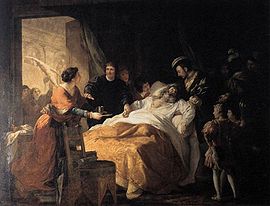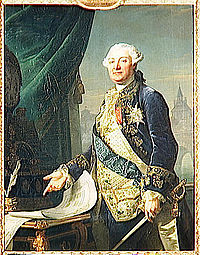
François-Guillaume Ménageot
Encyclopedia

François Boucher
François Boucher was a French painter, a proponent of Rococo taste, known for his idyllic and voluptuous paintings on classical themes, decorative allegories representing the arts or pastoral occupations, intended as a sort of two-dimensional furniture...
(1703–1770), he went on to win the Grand Prix de Rome and become a director of the French Academy in Rome
French Academy in Rome
The French Academy in Rome is an Academy located in the Villa Medici, within the Villa Borghese, on the Pincio in Rome, Italy.-History:...
, an academician and a member of the Institute.
Life
He was born in London, the son of Augustin Ménageot (d 1784), an art dealer and adviser to Denis DiderotDenis Diderot
Denis Diderot was a French philosopher, art critic, and writer. He was a prominent person during the Enlightenment and is best known for serving as co-founder and chief editor of and contributor to the Encyclopédie....
. François-Guillaume trained under first Jean-Baptiste-Henri Deshays
Jean-Baptiste-Henri Deshays
Jean-Baptiste-Henri Deshays or Deshayes was a French painter of religious and mythological subjects.-Life:Deshays was born in Colleville. His first training was under his father, the minor Rouen painter Jean-Dominique Deshays, he then spent a little time under Jean-Baptiste Descamps at his Ecole...
, then Joseph-Marie Vien
Joseph-Marie Vien
Joseph-Marie Vien , French painter, was born at Montpellier. He was the last holder of the post of Premier peintre du Roi, serving from 1789 to 1791....
, and finally François Boucher
François Boucher
François Boucher was a French painter, a proponent of Rococo taste, known for his idyllic and voluptuous paintings on classical themes, decorative allegories representing the arts or pastoral occupations, intended as a sort of two-dimensional furniture...
(1703–1770), in his early works adopting the latter's style and use of warm, light colours. His 1766 Tomyris
Tomyris
Tomyris, from the Persian تهمرییش Tahm-Rayiš, was a queen who reigned over the Massagetae, an Iranic people of Central Asia east of the Caspian Sea, in approximately 530 BC.- History :...
Plunging the Head of Cyrus
Cyrus the Great
Cyrus II of Persia , commonly known as Cyrus the Great, also known as Cyrus the Elder, was the founder of the Achaemenid Empire. Under his rule, the empire embraced all the previous civilized states of the ancient Near East, expanded vastly and eventually conquered most of Southwest Asia and much...
into a Bowl of Blood (Paris, Ecole Normale Supérieure des Beaux-Arts) won the Prix de Rome
Prix de Rome
The Prix de Rome was a scholarship for arts students, principally of painting, sculpture, and architecture. It was created, initially for painters and sculptors, in 1663 in France during the reign of Louis XIV. It was an annual bursary for promising artists having proved their talents by...
and a stay at the French Academy in Rome from 1769 to 1774.

Polyxena
In Greek mythology, Polyxena was the youngest daughter of King Priam of Troy and his queen, Hecuba. She is considered the Trojan version of Iphigenia, daughter of Agamemnon and Clytemnestra. Polyxena is not in Homer's Iliad, appearing in works by later poets, perhaps to add romance to Homer's...
to Hecuba
Hecuba
Hecuba was a queen in Greek mythology, the wife of King Priam of Troy during the Trojan War, with whom she had 19 children. These children included several major characters of Homer's Iliad such as the warriors Hector and Paris, and the prophetess Cassandra...
(Chartres
Chartres
Chartres is a commune and capital of the Eure-et-Loir department in northern France. It is located southwest of Paris.-Geography:Chartres is built on the left bank of the Eure River, on a hill crowned by its famous cathedral, the spires of which are a landmark in the surrounding country...
, Musée des Beaux-Arts) at the Salon, and it received a good reception, as did his entrance piece Learning Resisting the Passage of Time (1780; Paris, Ecole Normale Supérieure des Beaux-Arts) and his 1781 Death of Leonardo da Vinci in the Arms of Francis I
Francis I of France
Francis I was King of France from 1515 until his death. During his reign, huge cultural changes took place in France and he has been called France's original Renaissance monarch...
(Amboise, Hôtel de Ville). He and other painters led French painting to return to the Grand Style, with more horizontal compositions, more sculptural drapery, colder colouring and set in ever more monumental architecture. He died in Paris.
Works
- Tomyris Plunging the Head of Cyrus into a Bowl of Blood (1766; Paris, Ecole Normale Supérieure des Beaux-Arts)
- The Farewells of Polyxena to Hecuba (1777; Chartres, Musée des Beaux-Arts)
- Learning Resisting the Passage of Time (1780; Paris, Ecole Normale Supérieure des Beaux-Arts)
- Death of Leonardo da Vinci in the Arms of Francis I (1781; Amboise, Hôtel de Ville)
- AstyanaxAstyanaxIn Greek mythology, Astyanax was the son of Hector, Crown Prince of Troy and Princess Andromache of Cilician Thebe. His birth name was Scamandrius , but the people of Troy nicknamed him Astyanax In Greek mythology, Astyanax was the son of Hector, Crown Prince of Troy and Princess Andromache of...
Torn from the Arms of AndromacheAndromacheIn Greek mythology, Andromache was the wife of Hector and daughter of Eetion, and sister to Podes. She was born and raised in the city of Cilician Thebe, over which her father ruled...
(1783, Angers, Musée des Beaux-Arts) - Cleopatra Paying her Last Respects to AnthonyMark AntonyMarcus Antonius , known in English as Mark Antony, was a Roman politician and general. As a military commander and administrator, he was an important supporter and loyal friend of his mother's cousin Julius Caesar...
(1785; Angers, Musée des Beaux-Arts) - The Continence of ScipioScipio AfricanusPublius Cornelius Scipio Africanus , also known as Scipio Africanus and Scipio the Elder, was a general in the Second Punic War and statesman of the Roman Republic...
(1787; Zidlochovice Museum) - MeleagerMeleagerIn Greek mythology, Meleager was a hero venerated in his temenos at Calydon in Aetolia. He was already famed as the host of the Calydonian boar hunt in the epic tradition that was reworked by Homer....
Implored by his Family (1789; Paris, Louvre)

